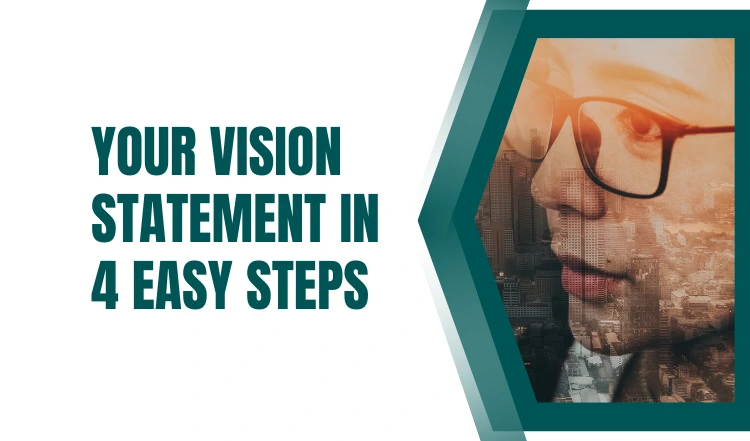Thanks to the Why You Need A Personal Vision Statement article, you already know the importance, and power, of having a thoughtfully written personal vision statement. Now, it’s time to create your own in just four quick steps.
Step 1: What Are Your Goals?
The first step in creating your personal vision step is going to be writing down your goals for your life. What do you want? Do you want to start a multi-million-dollar company? Do you want to become an astronaut? An artist? A stay-at-home parent?
You need to create this list before you go any further. Start by brainstorming. Get a sheet of paper and a pen (not a computer) and write down every single thing you’d like to do in your life. Don’t hold back and don’t censor yourself. Write down everything that comes to mind.
If you have a hard time doing this all at once, that’s okay. Take some time with it. Carry the list around with you for a few days and add to it whenever something crosses your mind. Keep going until you feel like it is completed.
Again, don’t worry about what anyone else’s list would look like. Everyone is different and unique. Every person has different goals. Your list of lifetime goals will be different from every person you know, even if you have an identical twin. That’s normal and to be expected.
Next, go down this list and think through every item you wrote down. Is this something that you want in your heart of hearts? Or is it something you think you want? Or that you think you should want? Mark these latter items off at once.
What’s left is a list of things you do want to achieve in your life. Which ones do you most want to accomplish? Some of them are going to exert a stronger pull on you than others. Put a star beside these.
After you’ve done that, go back through the list and consider the compatibility of all of your goals. You’re probably going to find that some of them are contradictory or at least can’t be accomplished together. You’re not going to become a famous actor and an astronaut at the same time, for example.
This is the hard part. It’s time to choose. You’re going to have to make some painful choices here -which goals do you want most? Which are you willing to sacrifice in order to get to the others? Mark off the ones that don’t make the cut. It will hurt, but you have to do it.
When you’re done, copy the surviving goals down onto a clean sheet of paper. This is the beginning of your vision statement.
Step 2: What Are Your Strengths, Skills, and Weaknesses?
The second step in creating your personal vision statement is to make a list of your strengths and skills and decide how they relate to what you want to do with your life. It’s time to get out the handy pen and paper again.
What are your strengths as a person? Write down everything you can think of. This is another brainstorming session. Don’t judge yourself, and don’t hold back because of uncertainty or insecurity.
Are you strong (physically or psychologically)? Stubborn? Independent? Are you a freethinker? Are you good at helping people get along? Are you highly intelligent? Empathic? Incredibly organized? You have a list of strengths, just like everyone else. Don’t stop with this list until you feel like you’ve covered them all.
Next, you’re going to do the same thing for your skills. List every skill you can think of that you have, in particular those that are related to the goals you identified in step one. What skills do you currently have that will help you get to those goals? How many of those are good to go, and which need work?
Now, look at the list of goals once again. What are the strengths a person who reaches each of those goals must possess? Go down the list and evaluate them one by one. Take your time with this; don’t rush this process. When you’re done, do it again and write down the list of skills needed to accomplish these goals.
You may have already guessed what the next step is going to be. You’re going to compare the two lists you’ve created -the one of strengths and skills you already have versus those that you need to accomplish all of these goals you want to achieve.
The differences between the two are your weaknesses. These are things you need to work on if you’re going to make all of your goals a reality. Circle all of these weaknesses.
If you like, you can add working on or developing some or all of these weaknesses to your personal vision statement. You don’t have to do so, but if you don’t, you still need to keep the list handy because you will have to work on these things if you want to reach your goals.
When you’ve finished with this step, set the lists you made aside -but keep them handy for later -and go on to the next step.
Step 3: What Are Your Values?
You’re almost ready to write your personal vision statement. You’ve written down your goals and come up with a list of strengths and skills you need to work on. The next part of the process is to decide what your most important values are.
As with steps 1 and 2, this step is going to yield different answers for everyone. There are no wrong answers, so don’t get anxious or worked up. All you’re going to do is decide what’s most important to YOU, not what is important to anyone else or that you think should be important.
Once more, you’ll need your pen and paper. Write “My Values” across the top. What’s the most important thing in the world to you? Your top priority, the thing you work so hard for, the one rule you always follow, the one guideline you use to define everything else in your life.
It’s a hard task, isn’t it? It may require some thought. Or maybe you know right away what it is. If so, you’re one of the lucky ones. The rest of us have to think about it for a while!
The answer, when you come up with it, might be simple, or it might be complex. It might be the Golden Rule. It could be taking care of your family. Making money is a top value for some people, while making a difference is most important to others. Some write a single word, such as “love” or “caring.”
Again, there are no wrong answers. This is about you and no one else. Your answers are private and should reflect your innermost self, or your vision statement won’t be genuine. Being honest with yourself is the most important part of this process.
Once you have an answer, you’re going to write down your second and third most important values. These might take you a while as well. You might even discover you have two or three on the same level. That’s okay too.
Now write down any other values you hold in high importance. Don’t write down too many; you don’t want to dilute the issue. You’re going to want to include your top value in your vision statement. Depending on your personality, you might want to do your second and third most important and maybe a few others as well.
When you finish with this exercise, you’ll be ready to write down your vision statement.
Step 4: Put it All Together
You’re almost finished. You’ve reached the final and most difficult step -combining everything into a coherent statement. If you’ve done the first three steps thoughtfully and honestly, you should be able to come up with a moving and motivational personal vision statement for yourself.
Get out a new sheet of paper. Write down all the things you’ve already come up with that need to be included in your vision statement. That is, write down your most important goals, any strengths or skills you want to include, and your personal values. These together form the nexus of your vision statement.
You’ll create drafts of your vision statement by playing around with words. Start a sentence with any of the following phrases and write until you have incorporated everything you want to include. Your vision statement may be anywhere from one sentence to a short paragraph long.
Vision Statement Opening Words
“I am…”
“I want…”
“My purpose/mission/vision is…”
“My life will show…”
“To…”
“I will…”
“I won’t…”
Don’t just try one set of these opening words. Try several. Play around with them. Come up with four or five draft vision statements. Use active, first-person verbs in all of them. That means you should write as “I [verb]” as much as you can.
Take some time with this, at least as much as you spent combined on the first three steps. Make multiple drafts of vision statements that all start with the same opening words. Add things in and take out other things. Use synonyms and antonyms.
Try different lengths, sentence structures, pacing, and tones. Make drafts that sound as different as possible while still expressing the same core set of beliefs.
How will you know when you’re finished? If you’re extraordinarily lucky or a talented wordsmith, you might be able to come up with the perfect vision statement just from these drafts. If not, keep working on drafts until you get tired of it or frustrated.
Set the task aside for a day or two, then come back and read your drafts again. Circle things that you really like. Mark out things you don’t. The bits and pieces that you like are going to form the core of your final draft.
Start making another set of drafts, and this time use only the phrases you’ve circled from your first drafts. Then repeat the process until you’ve formed a personal vision statement that suits you.
You’ll know when you’re finished.





